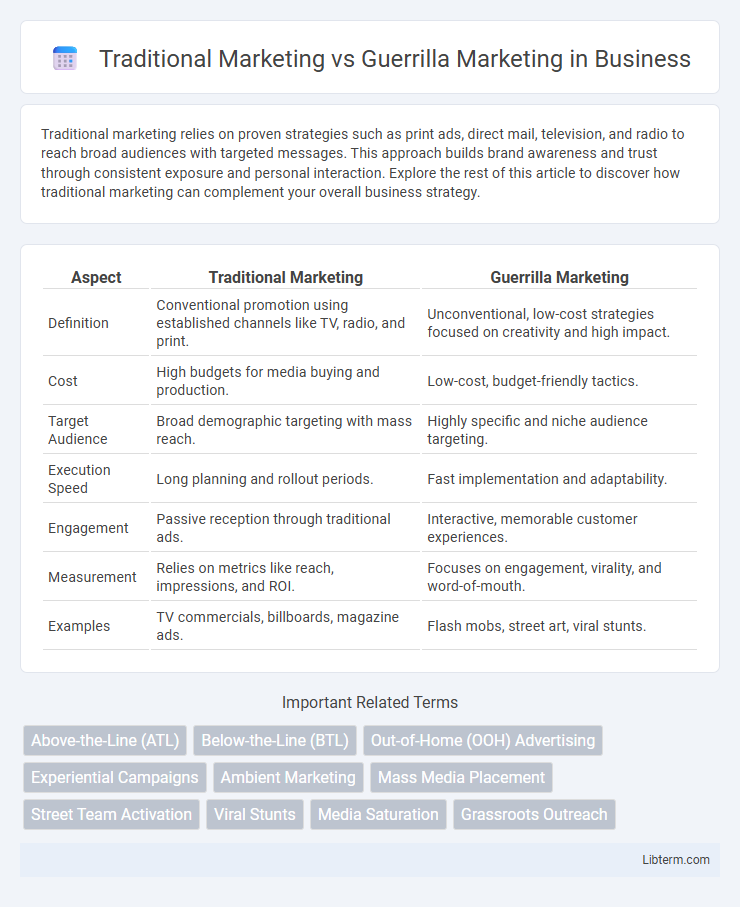Traditional marketing relies on proven strategies such as print ads, direct mail, television, and radio to reach broad audiences with targeted messages. This approach builds brand awareness and trust through consistent exposure and personal interaction. Explore the rest of this article to discover how traditional marketing can complement your overall business strategy.
Table of Comparison
| Aspect | Traditional Marketing | Guerrilla Marketing |
|---|---|---|
| Definition | Conventional promotion using established channels like TV, radio, and print. | Unconventional, low-cost strategies focused on creativity and high impact. |
| Cost | High budgets for media buying and production. | Low-cost, budget-friendly tactics. |
| Target Audience | Broad demographic targeting with mass reach. | Highly specific and niche audience targeting. |
| Execution Speed | Long planning and rollout periods. | Fast implementation and adaptability. |
| Engagement | Passive reception through traditional ads. | Interactive, memorable customer experiences. |
| Measurement | Relies on metrics like reach, impressions, and ROI. | Focuses on engagement, virality, and word-of-mouth. |
| Examples | TV commercials, billboards, magazine ads. | Flash mobs, street art, viral stunts. |
Understanding Traditional Marketing
Traditional marketing relies on established channels such as print media, television, radio, and outdoor advertising to reach broad audiences effectively. It emphasizes brand consistency, repeat exposure, and measurable campaign results through techniques like direct mail, billboards, and event sponsorships. Companies use traditional marketing to build trust and credibility by leveraging familiar platforms and structured strategies.
Defining Guerrilla Marketing
Guerrilla marketing is a creative, low-cost strategy designed to generate maximum exposure through unconventional, high-impact tactics that capture consumer attention in unexpected ways. Unlike traditional marketing, which relies on mass media channels such as TV, radio, and print to reach broad audiences, guerrilla marketing leverages street-level, viral, and experiential campaigns to create memorable brand interactions. This approach emphasizes innovation, surprise, and engagement, often utilizing public spaces and social dynamics to amplify visibility and emotional connection with the target market.
Key Differences Between Traditional and Guerrilla Marketing
Traditional marketing relies on established channels like TV, radio, and print ads to reach broad audiences, focusing on long-term brand building through consistent messaging. Guerrilla marketing uses unconventional, highly creative tactics such as street art, flash mobs, or viral social media campaigns to generate immediate buzz and customer engagement with limited budgets. Key differences include cost efficiency, audience targeting precision, and the emphasis on memorable, often interactive experiences unique to guerrilla strategies.
Cost Comparison: Traditional vs Guerrilla Marketing
Traditional marketing typically involves higher costs due to expenses like TV ads, print media, and billboard placements, often requiring significant budgets for production and distribution. Guerrilla marketing focuses on low-cost, creative tactics such as street art, viral campaigns, and social media stunts, maximizing impact with minimal financial investment. This cost-effective approach is ideal for small businesses seeking high ROI without the hefty price tag of traditional advertising.
Audience Reach and Targeting Strategies
Traditional marketing leverages mass media channels such as television, radio, and print, enabling broad audience reach but often lacks precise targeting capabilities. Guerrilla marketing employs unconventional tactics like viral campaigns and street promotions, delivering more focused engagement with niche or local audiences through creative and personalized strategies. Effective targeting in guerrilla marketing maximizes impact in specific demographic segments, whereas traditional marketing prioritizes extensive brand visibility across diverse consumer groups.
Creativity and Innovation in Marketing Campaigns
Traditional marketing relies on established channels such as TV, radio, and print ads, emphasizing broad reach and consistent messaging. Guerrilla marketing leverages creativity and innovation through unconventional, low-cost tactics that generate high engagement and memorable brand experiences. This approach often sparks viral attention and emotional connections, outperforming traditional methods in capturing consumer interest and driving brand loyalty.
Brand Awareness: Which Approach Works Best?
Traditional marketing leverages established channels like TV, radio, and print to build broad brand awareness through repetitive exposure and consistent messaging. Guerrilla marketing employs unconventional, high-impact tactics that create memorable experiences, generating buzz and viral potential with lower budgets. For maximizing brand awareness, traditional marketing excels in scalability and reach, while guerrilla marketing offers unique engagement and faster organic growth.
Measuring Success: Metrics and ROI
Traditional marketing success is commonly measured using metrics such as conversion rates, customer acquisition cost (CAC), and return on investment (ROI) derived from sales data and market share growth. Guerrilla marketing effectiveness relies on tracking engagement rates, social media shares, brand awareness uplift, and virality metrics to assess ROI in low-budget, high-impact campaigns. Combining quantitative data from traditional channels with qualitative social media insights provides a comprehensive view of overall marketing performance and ROI optimization.
Case Studies: Traditional and Guerrilla Marketing in Action
Coca-Cola's traditional marketing campaigns, such as Super Bowl commercials, showcase the power of mass media to build brand recognition and reach millions globally. In contrast, guerrilla marketing tactics like Red Bull's urban stunt events generate buzz through unconventional, low-cost strategies that engage audiences directly and virally. Analyzing case studies reveals that while traditional marketing excels in broad exposure, guerrilla marketing thrives on creativity and emotional connection for targeted impact.
Choosing the Right Strategy for Your Business
Traditional marketing relies on established channels such as television, radio, and print to reach broad audiences with consistent messaging. Guerrilla marketing employs unconventional, low-cost tactics designed to create high-impact, memorable interactions that engage target customers on a deeper level. Selecting the right strategy depends on your business goals, budget constraints, and target demographic, with traditional marketing offering wide reach and brand reinforcement, while guerrilla marketing provides innovative ways to capture attention and build customer loyalty.
Traditional Marketing Infographic

 libterm.com
libterm.com